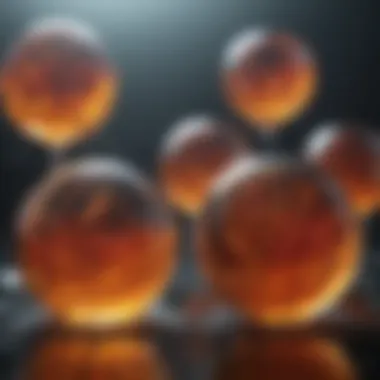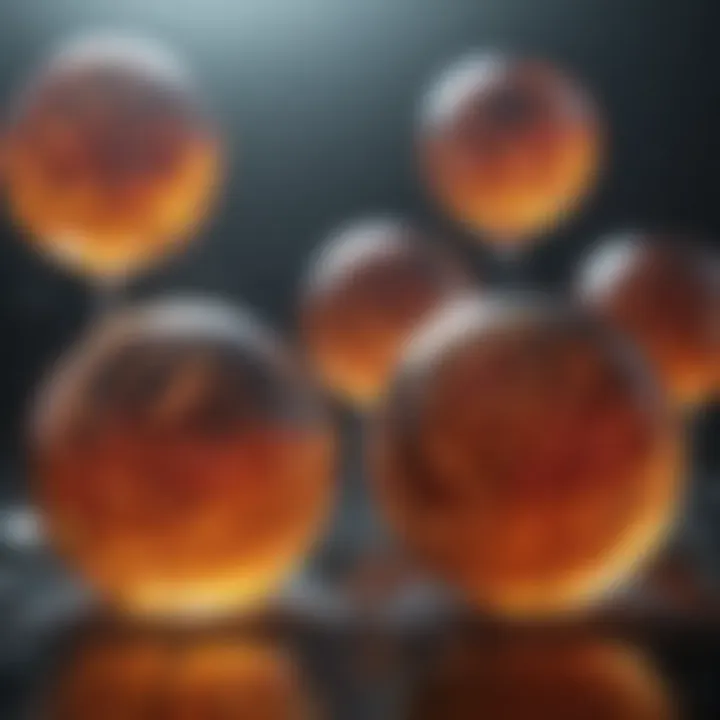Understanding Liquid Film: Characteristics and Applications


Article Overview
Liquid films are thin layers of liquid that form on surfaces or interfaces. They have significant implications in various scientific and engineering applications. The purpose of this article is to provide a detailed exploration of liquid films, examining their characteristics, formation, and importance within several fields, such as physics, chemistry, and engineering. Through a comprehensive overview, this article aims to illuminate the fundamental properties and behaviors of liquid films, along with their applications in real-world scenarios.
Purpose of the Article
This article serves multiple purposes. First, it seeks to educate readers about the basic nature and properties of liquid films. This foundational knowledge paves the way for understanding more advanced topics like theoretical frameworks and experimental methodologies. Additionally, the article discusses the most significant factors influencing liquid film behavior, offering insight into how these elements interplay within varied contexts. Lastly, it aims to highlight future research directions and potential technological advancements stemming from liquid film studies.
Relevance to Multiple Disciplines
Liquid films touch on various disciplines, making their study essential for a diverse audience. They are crucial in:
- Physics: Understanding fluid dynamics and surface tension.
- Chemistry: Exploring reaction mechanisms at surfaces.
- Engineering: Designing effective coatings and catalytic converters.
By studying liquid films, researchers and professionals can improve processes, innovate applications, and develop new technologies.
Research Background
A review of the historical context in which liquid films were studied sheds light on their importance.
Historical Context
The concept of liquid films has been explored since the earliest days of fluid mechanics. Initial studies concentrated on the behavior of liquids in contact with solids, examining their ability to form thin layers and how these layers could affect chemical reactions and physical properties. Over the decades, this research has expanded, giving rise to modern theories and practical applications in various sectors, from coatings to pharmaceuticals.
Key Concepts and Definitions
To engage meaningfully with the topic, several key concepts must be defined:
- Liquid Film: A continuous layer of liquid that rests on a surface or boundary.
- Surface Tension: The force that causes the surface of a liquid to contract and behave like a stretched membrane, crucial for understanding stability in liquid films.
- Capillary Action: The movement of liquid within the spaces of a porous material, which plays a significant role in the formation of liquid films.
These concepts are foundational for understanding the mechanisms governing liquid films and their behaviors. As the article unfolds, we will investigate each of these concepts in greater detail, connecting them to contemporary research and applications.
Foreword to Liquid Films
Liquid films are a fundamental subject within various scientific domains, playing an essential role in understanding material behavior and interactions. Their significance extends across physics, chemistry, and engineering, underlining their intricate nature and myriad applications. In this article, the discussion centers on different aspects of liquid films, focusing specifically on their properties, formation mechanisms, and roles in real-world scenarios.
Definition and Basic Concepts
At its core, a liquid film is a thin layer of liquid that can form between surfaces or within another medium. The concept encompasses various physical phenomena, from mundane occurrences like raindrops on a windshield to complex behaviors seen in biological systems. Liquid films can range in thickness, influencing their properties significantly.
The definition often extends to understanding surface tension, viscosity, and their collective roles in the formation and stability of these films. Surface tension, in particular, acts as a crucial player in determining how liquid films behave at interfaces. Understanding these basic concepts, allows scientists and engineers to predict how films will interact with different materials, which is essential for applications in coatings, emulsions, and fluid dynamics.
Historical Background
The study of liquid films has evolved over centuries. Early explorations can be traced back to the works of scientists like Leonardo da Vinci and Isaac Newton, who probed the behavior of liquids and their interactions with surfaces. However, it was not until the 19th century that significant advancements were made in understanding surface tension and its effects on fluids.
More recently, advancements in technology have propelled research in this area. The development of precise measurement techniques has enabled researchers to study the characteristics of liquid films at a much more granular level. This historical progression indicates a growing recognition of liquid films' complexity and their vital role in various processes, from industrial applications to environmental systems.
Understanding liquid films not only enriches scientific knowledge but also provides the groundwork for innovative solutions in many fields.
Physical Properties of Liquid Films
The physical properties of liquid films are crucial for understanding their behavior in various applications, ranging from industrial processes to environmental science. These properties dictate how liquid films interact with surfaces and other materials. Analyzing these characteristics allows for better predictions in fields like coatings, biological systems, and even climate science.
Surface Tension and Its Role
Surface tension is a fundamental characteristic of liquid films. It arises from the cohesive forces between liquid molecules at the surface. When molecules are at the surface, they experience different interactions than those deeper within the liquid. This difference creates a tendency for the surface to contract, forming a sort of 'skin' over the liquid.
In practical terms, surface tension affects how liquid films spread across surfaces. Higher surface tension means the liquid will bead up rather than spread, which can be advantageous in coatings or painting applications. Additionally, this property is essential in biological systems. For instance, the surfactants in the alveoli of the lungs reduce surface tension, facilitating gas exchange.
Viscosity Effects
Viscosity, another key property, refers to a liquid's resistance to flow. In liquid films, the viscosity can significantly alter how the film develops and stabilizes. A higher viscosity generally means slower flow, leading to thicker films with less movement. This can be beneficial in applications like oil recovery, where a thicker film can help trap and transport oil more efficiently.
Moreover, viscosity is affected by temperature and concentration of solutes in the film. As the temperature increases, viscosity often decreases, allowing for better fluid movement. Understanding this relationship is critical in designing systems where liquid films play an essential role.
Thickness Variability
Thickness variability in liquid films can arise from numerous factors, including the method of application and environmental conditions. Different applications will necessitate different film thicknesses, impacting performance. For instance, in coating technologies, a uniform thickness is required for optimal performance.
Additionally, environmental factors like humidity and temperature can affect how liquid films evaporate or support additional layers. Thin films might be required in sensitive applications like microelectronics, while thicker films may be preferred for protective coatings.
In summary, the physical properties of liquid films—surface tension, viscosity, and thickness variability—form the foundation for their behavior and applications. A deeper understanding of these aspects can lead to innovations and better efficiencies across various scientific fields.
Formation Mechanisms of Liquid Films
The formation mechanisms of liquid films are crucial to understanding their behavior and applications in various scientific fields. These mechanisms dictate how liquid films develop, grow, and stabilize. Analyzing these processes reveals essential insights that affect fields such as material science, chemical engineering, and environmental technology. By comprehending these mechanisms, researchers and professionals can optimize conditions for film formation, enabling more effective industrial processes and innovative applications.
Nucleation Processes
Nucleation is the initial step in the formation of a liquid film. It involves the emergence of small, stable clusters from a supersaturated system. In simpler terms, this process defines the moment when enough molecules congregate to establish a defined structure. The role of nucleation is significant, as it can determine the size and uniformity of the resultant film. There are two primary types of nucleation: homogeneous and heterogeneous.


- Homogeneous nucleation occurs in a uniform environment without any external influences. It is often less common due to the higher energy barrier required for stable clusters to form.
- Heterogeneous nucleation, on the other hand, occurs at interfaces or surfaces, such as solid-liquid or liquid-liquid interfaces. This type is generally favored because it requires less energy and is more efficient in practice.
Factors such as temperature, concentration, and surface properties are critical in influencing how nucleation transpires. To optimize nucleation, understanding these variables is essential.
Film Growth Dynamics
Once nucleation has taken place, the film growth dynamics take center stage. The growth of liquid films can occur through various mechanisms depending on environmental conditions and initial nucleation processes. Two main processes involved in film growth are diffusion and flow.
During film growth, molecules from the bulk phase migrate towards the forming film. This involves:
- Diffusion: Molecules move from regions of high concentration to lower concentration. The rate of diffusion directly affects the thickness and uniformity of the liquid film.
- Flow: This can arise from external forces, causing the film to reshape or redistribute. Liquid films may also experience shear flow, influenced by external pressure and surface tension.
Both processes can lead to variations in thickness. A well-controlled growth phase is essential for achieving desired properties in the final liquid film, which is paramount in applications ranging from coatings to thin-film technologies.
Stabilization Mechanisms
Stabilization mechanisms are fundamental in ensuring that a liquid film remains intact under various conditions. A stabilized film can maintain its structure and properties for a considerable duration, which is essential for many applications. Various factors contribute to the stabilization of liquid films.
Some common stabilization mechanisms include:
- Surface tension: This intrinsic property acts to balance the forces at the film's surface, maintaining its integrity.
- Additives: Surfactants and polymers can be introduced to enhance stability by reducing surface tension and inhibiting coalescence.
- External forces: Environmental conditions, such as temperature and pressure, can influence film stability, necessitating careful control during applications.
An understanding of these stabilization mechanisms is critical in designing systems that rely on liquid films, particularly in areas like coatings, pharmaceuticals, and environmental technologies.
"The mechanisms underlying the formation of liquid films are complex and multifaceted, essential for a myriad of scientific advancements and industrial applications."
"The mechanisms underlying the formation of liquid films are complex and multifaceted, essential for a myriad of scientific advancements and industrial applications."
In summary, the formation mechanisms of liquid films involve intricate processes of nucleation, growth, and stabilization. Each element plays a significant role in the overall behavior and practicality of liquid films within diverse fields. Understanding these principles not only advances scientific knowledge but also opens doors for innovative applications and solutions.
Types of Liquid Films
Liquid films are crucial in a variety of scientific and engineering contexts. Recognizing the different types of liquid films enhances our understanding of their behavior and applications. Each type exhibits unique characteristics, influencing how they interact with surfaces and other materials. This section explores three major types: thin liquid films, thick liquid films, and coating or emulsion films.
Thin Liquid Films
Thin liquid films typically range from a few nanometers to several micrometers in thickness. They often form at the interface between two phases, such as liquid-gas or liquid-liquid. These films are essential for applications such as anti-reflective coatings and in the development of sensors. One significant aspect is their stability, which can be influenced by surface tension and intermolecular forces. The properties of thin liquid films can lead to innovative technological advancements in electronics and optics.
"Understanding thin liquid film dynamics is essential for optimizing many industrial processes."
"Understanding thin liquid film dynamics is essential for optimizing many industrial processes."
When discussing thin films, one must consider critical parameters such as:
- Surface Tension: Determines the film's ability to maintain its shape and resist deformation.
- Viscosity: Affects the flow characteristics and stability of the thin film.
- Evaporation Rates: These can lead to thickness variations affecting performance.
Thick Liquid Films
Thick liquid films exceed micrometer thickness and are generally more stable than their thinner counterparts. They are often found in applications like lubrication and in certain biological systems. The thickness allows for a substantial volume of fluid, which can distribute load and minimize friction. The behavior of thick liquid films is governed by gravity, viscosity, and surface tension, which can create complex interactions at their boundaries.
Thick films show advantages in:
- Mechanical Support: They provide a cushion that helps in weight distribution.
- Thermal Insulation: Thick layers can serve as thermal barriers.
- Chemical Resistance: A greater amount of liquid can offer improved resistance to corrosive environments.
Each of these factors must be evaluated when designing applications that utilize thick liquid films, ensuring performance and effectiveness in their specific uses.
Coating and Emulsion Films
Coating films and emulsions represent a unique category, often involving a mixture of liquids with different properties. Coating films are used to create protective barriers on surfaces, enhancing their durability and performance. They can be formulated to provide specific characteristics, such as UV protection or anti-corrosive qualities.
Emulsion films consist of two immiscible liquids, commonly an oil and a water phase. The stability of these films is vital for applications in food, pharmaceuticals, and cosmetics. Some properties to consider are:
- Stability: The emulsifying agents used can determine longevity and performance of the film.
- Viscosity Control: Adjusting the viscosity can influence the application method and effectiveness.
- Droplet Size: In emulsions, smaller droplets generally lead to higher stability.
By understanding these types of liquid films, researchers and practitioners can leverage their unique properties to innovate in various applications, spanning industries from manufacturing to healthcare.
Applications of Liquid Films
Liquid films play a crucial role in various applications across different scientific fields. Their unique properties and behaviors contribute significantly to industrial processes, environmental management, and biological systems. By understanding these applications, we can better appreciate the importance of liquid films in both practical and theoretical contexts.
Industrial Processes
Coating Technologies
Coating technologies utilize liquid films to create protective layers on various surfaces. This application is critical for enhancing durability and appearance. The main characteristic of these technologies is their ability to effectively reduce wear and corrosion on materials like metals and plastics. The appeal of coating technologies lies in their versatility, allowing for different formulations tailored to specific performance requirements.
One notable aspect of coating technologies is the use of polymers, which provide excellent adhesion and flexibility. However, certain methods may involve solvents that can pose environmental concerns. Balancing performance with sustainability remains a challenge in this field.
Oil Recovery
Oil recovery techniques heavily depend on liquid films to optimize the extraction of crude oil. The primary advantage of this method is that it maximizes the efficiency of recovery processes, which is essential in the oil industry. Enhanced oil recovery methods often involve injecting liquid agents that alter the properties of the oil, improving its flow and making extraction easier.


A key characteristic of oil recovery methods is their ability to improve yield rates from existing wells. However, there are disadvantages, such as the potential environmental impact and the cost involved in advanced recovery techniques. Continuous research aims to mitigate these issues while improving extraction efficiency.
Cooling Systems
Cooling systems leverage liquid films to manage temperature in various industrial applications. This essential aspect helps maintain optimal operating conditions, preventing overheating and ensuring reliability. Liquid films in these systems are effective in heat transfer due to their ability to cover surfaces uniformly.
The uniqueness of cooling systems lies in their design, which can be optimized for specific environments and processes. Yet, the maintenance and operation of these systems often require careful monitoring to prevent issues like scaling or fouling, which can hinder performance.
Environmental Considerations
Pollution Control
Pollution control mechanisms often utilize liquid films to minimize harmful emissions and contaminants. This application is significant in mitigating the adverse effects of industrial activities on the environment. The critical feature of pollution control is its efficacy in absorbing or neutralizing pollutants before they are released into the atmosphere.
The appeal of using liquid films lies in their ability to operate effectively over large surface areas, maximizing contact with pollutants. However, the challenge remains in scaling these systems to manage larger operations while ensuring effectiveness. This demands ongoing research and technological innovation.
Water Purification
Water purification processes frequently employ liquid films to facilitate the removal of impurities from water sources. This application is essential for providing safe drinking water and protecting public health. The unique characteristic of water purification methods that use liquid films is their efficiency in filtering out contaminants at a microscopic level.
While effective, the challenge lies in maintaining the integrity of the filtration media over time. Backwashing and replacement of filters can be resource-intensive, which may affect overall sustainability. Addressing these challenges presents opportunities for innovation in water treatment technologies.
Biological Systems
Cell Membranes
Cell membranes are an essential example of liquid films in biological systems. They regulate the movement of substances in and out of cells, playing a critical role in maintaining homeostasis. The key characteristic of cell membranes is their selective permeability, allowing certain molecules to pass while blocking others.
This selectivity is beneficial for cellular function but can also pose challenges, especially in drug delivery systems. Delivering therapeutic agents effectively without compromising cell integrity is an area of ongoing research. Understanding the properties of liquid films can enhance the design of these delivery systems.
Biochemical Reactions
Biochemical reactions often occur at interfaces formed by liquid films. These reactions are vital for various biological processes, including metabolism and cellular signaling. The unique feature of biochemical reactions at liquid film interfaces is their efficiency, allowing for rapid interaction between reactants.
However, the complexity of these systems can lead to challenges in controlling reaction conditions. This aspect requires careful experimentation and modeling to optimize the desired outcomes. Further study of liquid films will likely provide insights into enhancing biochemical reactions for medical and industrial applications.
Theoretical Models of Liquid Films
The understanding of liquid films requires a solid grasp of theoretical models. These models aid in explaining the complex behaviors of liquid films under various conditions. They provide insights into how liquid films interact with their environment and how their properties change with different external factors. By employing these models, researchers can predict the behavior of liquid films, which is crucial for applications in various fields, including chemical engineering, materials science, and environmental technology.
Continuum Mechanics
Continuum mechanics is a fundamental theoretical model for studying liquid films. It assumes that matter is continuous, enabling the description of liquid behavior in a fluid-like manner. This approach allows one to derive equations that govern film dynamics, such as the Navier-Stokes equations. These equations describe the flow characteristics and behavior of liquids at a macroscopic level.
In analyzing liquid films, continuum mechanics aids in addressing phenomena like shear stress and viscosity. These factors play significant roles in how films deform and flow under external influences. Understanding these aspects is critical for designing industrial processes where liquid films are involved, such as coating applications.
Key points about continuum mechanics in liquid films include:
- It simplifies complex interactions into manageable equations.
- It provides predictive insights for engineering applications.
- It is essential for simulating film behavior under varying conditions.
Molecular Dynamics
Molecular dynamics represents a different approach, focusing on the microscopic interactions between molecules within a liquid film. Instead of treating the film as a continuum, this model provides a detailed view of molecular behavior. This approach is essential for understanding phenomena like diffusion and molecular interactions at the interface.
Using computational simulations, researchers can examine how changes in temperature, pressure, and other factors influence the motion of molecules within a film. This model is particularly useful in studying thin films, where the behavior of individual molecules significantly impacts the overall properties of the film.
Benefits of molecular dynamics for liquid films include:
- The ability to simulate realistic molecular interactions.
- Insights into nanoscale properties that can influence macroscopic behavior.
- Enhanced understanding of fluid behaviors at lower scales.
Statistical Mechanics Approaches
Statistical mechanics provides a framework for connecting macroscopic properties with microscopic behaviors. In the context of liquid films, it allows the derivation of thermodynamic properties from the statistical behavior of molecules. This approach is vital for understanding the thermodynamic stability of films and predicting phase changes.
Statistical mechanics considers the distribution of molecular states and how these affect bulk properties. For instance, it helps explain why thin liquid films exhibit unique stability and behavior when subjected to external stresses like changes in temperature or pressure. This makes it a valuable tool for researchers studying film stability and transition states.
Key aspects of statistical mechanics relating to liquid films are:
- Establishing a link between microscopic interactions and bulk properties.
- Predicting phase behavior and stability.
- Understanding the thermodynamics involved in liquid film interactions.
Understanding these theoretical models is essential for advancing research on liquid films. They help go beyond mere observations and provide a deeper comprehension of the underlying principles governing liquid film behavior.
Understanding these theoretical models is essential for advancing research on liquid films. They help go beyond mere observations and provide a deeper comprehension of the underlying principles governing liquid film behavior.
Experimental Techniques for Studying Liquid Films
The study of liquid films is crucial in numerous scientific and engineering fields. Understanding the behavior, thickness, and stability of these films can lead to significant advancements in technology and environmental science. The development and improvement of various experimental techniques play an essential role in this endeavor. These methodologies provide insights into the characteristics of liquid films, and their results can shape theoretical frameworks and innovative applications across diverse disciplines.
Interferometry
Interferometry is a powerful optical technique used to measure the properties of liquid films with high precision. By utilizing the interference of light waves, researchers can discern minute changes in film thickness and refractive index. This method offers several benefits:


- High Sensitivity: Interferometry can detect variations at the nanometer level.
- Real-Time Monitoring: It allows for the observation of film formation and growth dynamics in situ.
- Non-Destructive Testing: The technique does not alter the sample, preserving its integrity.
Applications of interferometry in studying liquid films include the analysis of surface tension effects and the evaluation of stabilization mechanisms. Moreover, recent advances in digital holographic interferometry have further expanded its capabilities, offering three-dimensional imaging of liquid film distribution.
Microscopy Methods
Microscopy methods are instrumental in visualizing liquid films at various resolutions. Techniques such as atomic force microscopy (AFM) and scanning electron microscopy (SEM) provide detailed images of film morphology and surface characteristics. The key advantages of microscopy methods include:
- Topographical Mapping: They enable researchers to create precise surface profiles of the films.
- Morphological Analysis: Microscopy facilitates the examination of structures and defects within the films.
- Investigating Interactions: It allows for the observation of film interactions with other substances, such as contaminants or stabilizers.
These insights can lead to improvements in product formulations, enhancing the performance of coatings and emulsions significantly.
High-Speed Imaging
High-speed imaging is another cutting-edge technique used to study the dynamic behavior of liquid films. It captures rapid changes during the film formation and retraction process. This method is essential for understanding:
- Dynamic Instabilities: High-speed imaging can reveal the onset of instabilities that affect film stability.
- Growth Patterns: It provides real-time visuals of how liquid films evolve under different conditions.
- Deformation Responses: The method can capture the response of films to external forces, such as shear or pressure changes.
Capturing these fast transient events helps researchers devise better stabilization strategies and improve formulations in various applications such as coatings, lubricants, and biological systems.
The advancement of experimental techniques significantly enriches our understanding of liquid films, facilitating both theoretical and practical innovations in numerous scientific fields.
The advancement of experimental techniques significantly enriches our understanding of liquid films, facilitating both theoretical and practical innovations in numerous scientific fields.
Impact of Environmental Factors on Liquid Films
Understanding how environmental factors shape the behavior of liquid films is crucial. These films are dynamic structures, sensitive to slight modifications in their environment. Comprehending these influences helps in both academic research and practical applications. This section will explore how temperature, humidity, and air pressure significantly affect liquid films, highlighting key elements that govern their functionality.
Temperature Variations
Temperature variations can drastically change the properties of liquid films. The behavior of molecules within these films is temperature dependent. As temperature rises, molecular activity increases, which can lead to a decrease in viscosity. This change allows liquid films to flow more easily but can also affect stability. For instance, in industrial processes, maintaining an optimal temperature is essential for ensuring uniform coating in painting or surface treatments. Conversely, too high temperatures could promote evaporation, disrupting film formation.
- Increased temperature typically leads to:
- Reduced surface tension
- Higher volatility of liquids
- Faster diffusion rates
These factors can impact how liquid films interact with surfaces or other fluids, leading to various results in applications such as coatings and chemical reactions.
Humidity Effects
Humidity plays a significant role in the behavior and stability of liquid films. High humidity can enhance the formation of thin liquid films on surfaces. This phenomenon often occurs in natural settings, such as dew forming on grass. In controlled environments, proper humidity regulation is necessary for processes like semiconductor manufacturing, where a uniform film is critical.
Moreover, increased humidity influences the adhesion properties of liquid films. This effect can be beneficial in adhesive applications or detrimental in scenarios where unwanted moisture is present. Essential aspects to consider include:
- Film thickness variation with humidity levels
- Impact on drying times in coatings
- Changes in chemical reactions due to moisture
Air Pressure Influence
Air pressure can influence the formation and stability of liquid films. The behavior of these films can change under different pressures, impacting applications in aerospace or biomedical fields. Lower air pressure often leads to increased evaporation rates, which can be detrimental when attempting to maintain a stable film. High pressures, on the other hand, can compress a film, altering its thickness and flow properties.
When considering air pressure, factors to analyze include:
- Variation in evaporation rates
- Changes in boiling points for liquid films
- Effects on the interactions between liquids and gases
Future Directions in Liquid Film Research
Research into liquid films is evolving rapidly, embracing new methodologies and technological advancements. This section outlines the future directions that hold potential for significantly impacting scientific and practical applications of liquid films. Understanding these directions can pave the way for innovative solutions across various industries, enhancing overall efficiency and effectiveness.
Advancements in Computational Techniques
Computational techniques play a crucial role in liquid film research, allowing for the simulation of complex phenomena that are difficult to observe experimentally. One significant advancement is the use of machine learning algorithms to predict film behavior under varying conditions. These algorithms analyze large datasets, helping scientists understand patterns and make accurate predictions.
Furthermore, high-performance computing has enabled researchers to create detailed models that can simulate thousands of molecular interactions simultaneously. This provides deeper insights into the molecular dynamics of liquid films, improving both the quality and speed of research outcomes.
Notable applications of these advancements include:
- Enhanced prediction of coating behaviors in industrial processes.
- Real-time simulations for oil recovery techniques, improving yield metrics.
- Insights into the thermal properties of films in cooling systems.
Innovations in Experimental Design
Innovative experimental designs are pivotal for advancing liquid film research. New methods are being developed to study liquid films in more controlled environments, leading to more accurate results. For instance, microfluidics allows researchers to manipulate liquid flow on a microscale. This technology aids in studying the formation and stabilization of films with precision.
Incorporating automated measurement techniques can also elevate research quality. For example, integrating sensors that measure real-time thickness, temperature, and other properties can offer valuable data in various experiments. Some key innovations include:
- Development of in situ measurement techniques that monitor films while they form.
- Utilization of advanced visualization technologies, such as high-speed cameras, for observing dynamic changes in liquid films.
Interdisciplinary Collaborations
The complexity of liquid film behavior necessitates a multidisciplinary approach in research. Collaborations between disciplines such as physics, chemistry, biology, and engineering can foster groundbreaking developments. For instance, merging principles from nanotechnology with liquid film studies can lead to the design of novel coatings with unique properties.
Key benefits of these collaborations include:
- Broader perspectives on liquid film applications in biological systems, enhancing understanding of cellular processes.
- Innovative approaches to environmental challenges, such as pollution control, through the integration of chemical engineering methods.
- Strengthened research funding opportunities and resource sharing, allowing institutions to maximize their capabilities.
"The future of liquid film research lies at the intersection of diverse scientific disciplines, revealing pathways that traditional approaches may overlook."
"The future of liquid film research lies at the intersection of diverse scientific disciplines, revealing pathways that traditional approaches may overlook."



